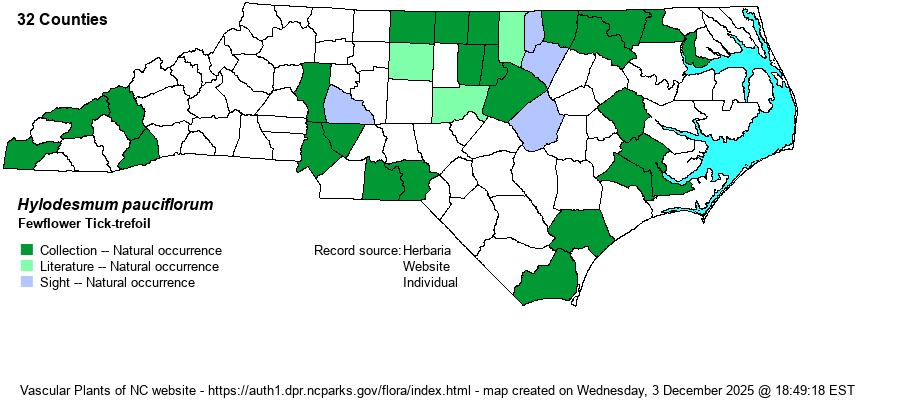| Author | (Nuttall) H. Ohashi & R.R. Mill | |
| Distribution | Very widely scattered over most of the state, but primarily found in the northeastern Piedmont and northern Coastal Plain. Probably absent in the far eastern Coastal Plain and in the northern Mountains.
This is a Southeastern species that ranges north to NY and southeastern KS, and south to western FL and eastern TX. It is very scarce north of northern VA. | |
| Abundance | Uncommon in the northeastern Piedmont and far northern Coastal Plain -- from Rockingham County east to Hertford County and south to Chatham and Johnston counties. Rare and of spotty occurrence elsewhere. The NCNHP formerly considered this as a Watch List species, but recent field work (in the last decade or two) in the northern part of the state uncovered many new populations, and it no longer is on that list. | |
| Habitat | This is the only tick-trefoil that is regularly found in moist or rich bottomland hardwood forests. It ranges from that habitat onto lower hardwood slopes, typically where the soil is quite moist and often high in pH. Where found, it is usually mixed with a number of other broadleaf herbaceous species in a high diversity setting. | |
| Phenology | Blooms from June to August, and fruits from August to October. | |
| Identification | This is a small, low-growing tick-trefoil that is often overlooked, in part owing to its low growth but also passed over as the very common American Hog-peanut (Amphicarpaea bracteata). Whereas that last species is a trailing or twining vine, Hylodesmum pauciflorum is a somewhat erect herb, but reaching barely 8-12 inches tall, if even that. It has a branched stem, such that it is often wider than tall; the somewhat numerous leaves are crowded on the plant, even near the ground; and each leaf is composed of 3 leaflets. The terminal leaflet is ovate to somewhat rhombic, and about 2 inches long and slightly less wide, with the lateral leaflets a bit smaller. The flowers are quite distinct for a tick-trefoil. There are a few rather short panicles of flowers, each only a few inches long, and populated with only several flowers each. However, the flowers are bright white (and not pink like in nearly all similar species) and are held slightly above the level of the leaves. The pods have only 1-3 segments (loments). Experienced observers can recognize this "interesting" legume without flowers or fruits, by noticing trifoliate leaves on a very short plant that is "erect" and not a vine. Also, the species normally grows in moderate to dense stands, not singly like many others in Hylodesmum and Desmodium. Of course, if you are walking in a bottomland or lower slope of a rich forest, and notice fairly small white flowers in late summer on a legume, you may well have found this uncommon species. | |
| Taxonomic Comments | This species was formerly included in the genus Desmodium. Most references now have moved it to Hylodesmum, but some like NatureServe retain the Desmodium pauciflorum name.
| |
| Other Common Name(s) | Few-flowered Tick-trefoil (variation of the same general name) | |
| State Rank | S3 | |
| Global Rank | G5 | |
| State Status | | |
| US Status | | |
| USACE-agcp | | |
| USACE-emp | | |

